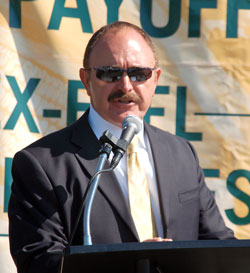 Well, from head to shoe really. The E-logo is everywhere here at the Brickyard. From IndyCars and trailers to flags and t-shirts. But, so far, the most interesting places I spotted the logo during this year’s Indy 500 race weekend were on a ‘Cat in the Hat’ style hat and painted on a Keds kid-sized shoe.
Well, from head to shoe really. The E-logo is everywhere here at the Brickyard. From IndyCars and trailers to flags and t-shirts. But, so far, the most interesting places I spotted the logo during this year’s Indy 500 race weekend were on a ‘Cat in the Hat’ style hat and painted on a Keds kid-sized shoe.
Mark Lackner is the owner of the “special replica” of the Team Ethanol IndyCar. He says he won the painted shoe at a trucker’s event. He explained the “paint job” was done with official Team Ethanol IndyCar paint. I spotted him at the IndyCar driver autograph session where he was  snagging a signature from former Team Ethanol Driver Jeff Simmons. Now, the shoe is signed by both Jeff and current Team Ethanol driver Ryan Hunter-Reay. I pointed out the shoe to Joanna Schroeder, the Director of Communications for the Ethanol Promotion and Information Council. She is going to have Bobby Rahal sign the shoe so Mark has a complete collection of sigs. She’s also sending him a real replica of the the Team Ethanol car. Mark has the Simmons and Hunter-Reay replicas, but not the Paul Dana replica. Joanna is making sure Mark’s collection of Team Ethanol IndyCar replicas is complete too.
snagging a signature from former Team Ethanol Driver Jeff Simmons. Now, the shoe is signed by both Jeff and current Team Ethanol driver Ryan Hunter-Reay. I pointed out the shoe to Joanna Schroeder, the Director of Communications for the Ethanol Promotion and Information Council. She is going to have Bobby Rahal sign the shoe so Mark has a complete collection of sigs. She’s also sending him a real replica of the the Team Ethanol car. Mark has the Simmons and Hunter-Reay replicas, but not the Paul Dana replica. Joanna is making sure Mark’s collection of Team Ethanol IndyCar replicas is complete too.
The video of the 2008 Corvette winners is finally uploaded on Youtube. Click here to view our post with the video.


 The American Automobile Association (AAA) predicts that nearly 32 million drivers will hit the road for the long holiday weekend. However, the
The American Automobile Association (AAA) predicts that nearly 32 million drivers will hit the road for the long holiday weekend. However, the  The oil executives defended their profits and the price increases with statements such as, “The fundamental laws of supply and demand are at work,” made by John Hofmeister, chairman of Shell Oil.
The oil executives defended their profits and the price increases with statements such as, “The fundamental laws of supply and demand are at work,” made by John Hofmeister, chairman of Shell Oil.  The Democratic National Convention in Denver will be fueled with ethanol made from beer waste, thanks to a donation from
The Democratic National Convention in Denver will be fueled with ethanol made from beer waste, thanks to a donation from  Molson Coors is donating all the ethanol fuel for the fleet of General Motors flex-fuel vehicles to be used for Convention transportation needs. Coors’ ethanol is made from waste beer generated at their brewery in Golden, Colo.
Molson Coors is donating all the ethanol fuel for the fleet of General Motors flex-fuel vehicles to be used for Convention transportation needs. Coors’ ethanol is made from waste beer generated at their brewery in Golden, Colo.  The
The  The U.S. House today has passed a measure seen as important because it extends renewable energy production and investment tax credits has cleared its latest hurdle. H.R. 6049, the Renewable Energy and Job Creation Act of 2008, got through the U.S. House by a 263-160 margin.
The U.S. House today has passed a measure seen as important because it extends renewable energy production and investment tax credits has cleared its latest hurdle. H.R. 6049, the Renewable Energy and Job Creation Act of 2008, got through the U.S. House by a 263-160 margin. Biodiesel-powered vehicles were the dominating force during this year’s Challenge X… a four-year engineering competition with 17 university teams from across North America developing General Motors vehicles using alternative energies.
Biodiesel-powered vehicles were the dominating force during this year’s Challenge X… a four-year engineering competition with 17 university teams from across North America developing General Motors vehicles using alternative energies.  The Mississippi State team designed a through-the-road parallel hybrid electric vehicle powered by a 1.9L GM direct injection turbo diesel engine fueled by bio diesel (B20). It achieved a 38 percent increase in fuel economy over the production vehicle on a modified urban test cycle.
The Mississippi State team designed a through-the-road parallel hybrid electric vehicle powered by a 1.9L GM direct injection turbo diesel engine fueled by bio diesel (B20). It achieved a 38 percent increase in fuel economy over the production vehicle on a modified urban test cycle. The 2008 Indy Pace Car corvette wasn’t the only shiny new toy to check out at the giveaway this morning. The
The 2008 Indy Pace Car corvette wasn’t the only shiny new toy to check out at the giveaway this morning. The  I caught up with Indiana Corn’s Mark Walters again, as well as ICMC’s Mike Shuter (pictured), the council’s President and a Frankton, IN farmer. We talked about the new mobile marketing unit, the truth about ethanol as they see it and how IN corn fits into the ethanol industry. You can listen to my interview with Mark and Mike here: [audio:http://www.zimmcomm.biz/epic/shuter-walters-indy.mp3]
I caught up with Indiana Corn’s Mark Walters again, as well as ICMC’s Mike Shuter (pictured), the council’s President and a Frankton, IN farmer. We talked about the new mobile marketing unit, the truth about ethanol as they see it and how IN corn fits into the ethanol industry. You can listen to my interview with Mark and Mike here: [audio:http://www.zimmcomm.biz/epic/shuter-walters-indy.mp3]
 The
The  Taking the 2008 Corvette is fun… and a bit dangerous. Tom Severino will promise you that. Tom is the Vice President and Market Manager of Emmis Indianapolis radio, the parent company of Hank FM. I spoke with Tom about Hank FM’s joint effort with the
Taking the 2008 Corvette is fun… and a bit dangerous. Tom Severino will promise you that. Tom is the Vice President and Market Manager of Emmis Indianapolis radio, the parent company of Hank FM. I spoke with Tom about Hank FM’s joint effort with the  Well winners, really. And no, they’re not the two cute girls to the right. They were so cute though that I had to use their picture. It was Darron Stewart and his two sons that had brought the magic touch from Carmel, IN to a certain red buzzer. The troupe won a 2-year lease to a 2008 Indy pace car corvette at this morning’s special giveaway. The giveaway was the final event in a month-long promotion to raise awareness of ethanol.
Well winners, really. And no, they’re not the two cute girls to the right. They were so cute though that I had to use their picture. It was Darron Stewart and his two sons that had brought the magic touch from Carmel, IN to a certain red buzzer. The troupe won a 2-year lease to a 2008 Indy pace car corvette at this morning’s special giveaway. The giveaway was the final event in a month-long promotion to raise awareness of ethanol.